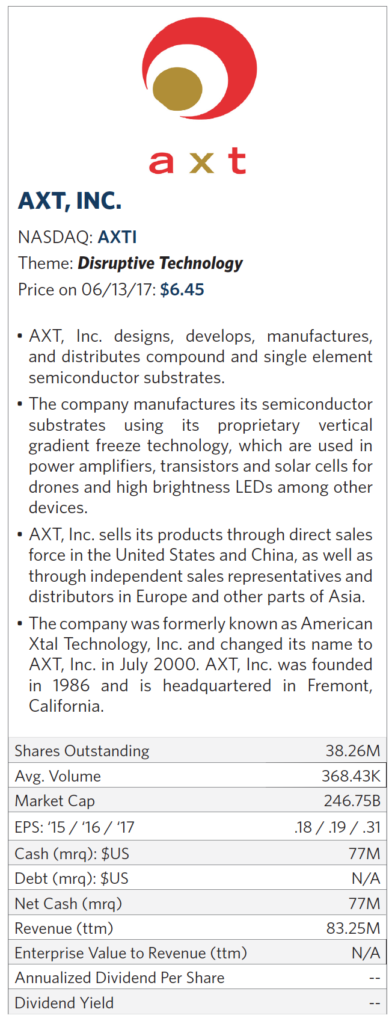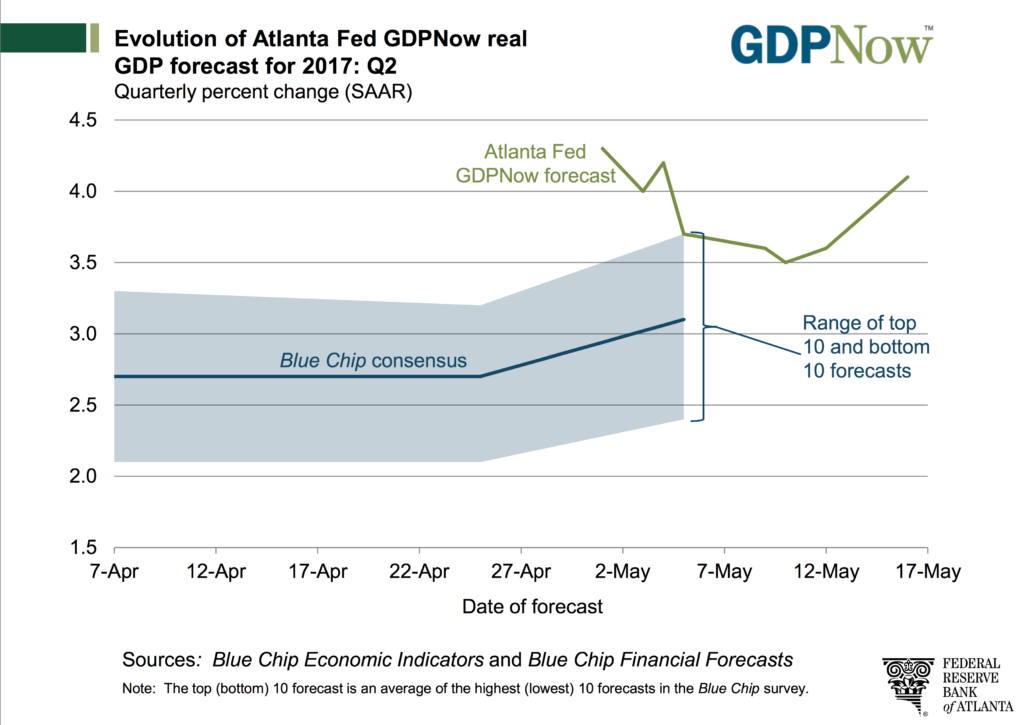In this Week’s Issue:
- Let Luck Be Our Lady — Adding MGM Resorts to the Tematica Select List
- Fallout from Apple’s WWDC 2017 Event Has Us Upping Stop-Loss on OLED
- The Apple Halo Effect Shines on More than Just the iPhone Ecosystem
- Apple’s HomePod Announcement Also Has Implications on AMZN, GOOGL and NUAN, Leading Us to Instill a Stop-Loss on Nuance
Since last week’s issue of Tematica Investing, we have to say that things more or less remain unchanged. All three major market indices are up, led by the Nasdaq and the same group of companies that have powered its outperformance relative to the S&P 500 and the Dow Jones Industrial Average since mid-January. Most of these same stocks — Amazon (AMZN), Alphabet (GOOGL) and Facebook (FB) — have powered the Tematica Select List higher, but we’ve also benefitted from continued climb in Universal Display (OLED), Applied Materials (AMAT), and USA Technologies (USAT), each of which is being driven by its own aspect of our various investing themes.
In the race to reach $1,000, we’ve seen both AMZN and GOOGL shares cross and move back from that would be magical line in the sand. From our perspective, much like a tailor tells us when we cringe at our waist size when getting measured for a new suit – it’s just a number. At least when it comes to our age and waist size!
What matters most when assessing a stock price is whether the thematic tailwinds are still blowing, and in the case of both Amazon and Alphabet, it’s a resounding yes. Even as the shares encroach upon our respective price targets — $1,100 for Amazon and $1,050 for Alphabet — we continue to see signs that the core respective investing themes – Connected Society and Asset-Lite Business Models – show no signs of abating. As we’ve said before, even as we look to once again revisit our price targets, much the way we have with Universal Display shares as its outlook has strengthened over the last several months, these are stocks to own, not trade. That remains our position.
Even as those names have moved higher this past week, we’ve seen investor appetite favor some of our more defensive names, including McCormick & Co. (MKC) and International Flavors & Fragrances (IFF), both of which are up more than 1 percent over the last five days. Not surprisingly, we are seeing these kinds of companies, the ones that have a rising dividend policy and inelastic aspects to their businesses, come back into favor as uncertainty once again creeps back into the market.
 Whether it’s the recent happenings in London, fired FBI Director James Comey’s pending testimony before Congress, investigations into Russian meddling, Trump once again trying to pivot his policy efforts to get out of stall speed, the European Central Bank meeting or elections in Britain, there is no shortage of things to preoccupy investors. As we keep one eye and ear on these events, we’ll continue to watch the data unfold and make our moves accordingly with the Tematica Select List. As we shared in this week’s Monday Morning Kickoff and described in last week’s Cocktail Investing Podcast, we are seeing GDP expectations for the current quarter begin to wither and beginning to see downward revisions for 3Q 2017 as well. It’s going to make for an interesting summer, but we’ll be there to guide you through it.
Whether it’s the recent happenings in London, fired FBI Director James Comey’s pending testimony before Congress, investigations into Russian meddling, Trump once again trying to pivot his policy efforts to get out of stall speed, the European Central Bank meeting or elections in Britain, there is no shortage of things to preoccupy investors. As we keep one eye and ear on these events, we’ll continue to watch the data unfold and make our moves accordingly with the Tematica Select List. As we shared in this week’s Monday Morning Kickoff and described in last week’s Cocktail Investing Podcast, we are seeing GDP expectations for the current quarter begin to wither and beginning to see downward revisions for 3Q 2017 as well. It’s going to make for an interesting summer, but we’ll be there to guide you through it.
As we get ready for the soon to be on us summer, we’ll be reviewing both price targets and stop losses up and down the Tematica Select List. Now, let’s get to some updates and a new recommendation that centers on our Guilty Pleasure investing theme.
Let Luck Be Our Lady — Adding MGM Resorts to the Tematica Select List
Our Guilty Pleasure investing theme examines a variety of companies and businesses that range from alcohol, beer and spirits to chocolate, tobacco and gaming. We examine each of these, and when the time is right, meaning a thematic tailwind is blowing and there is sufficient net upside to be had, we’ll add shares to the Tematica Select List. That’s what we’re doing today with MGM Resorts International [stock_quote symbol=”MGM” show=”symbol”] shares.
While widely recognized mostly for its domestic gambling and hospitality business that includes casino, rooms, food and beverage, entertainment and retail-related revenue, we are adding MGM shares to the Tematica Select List primarily because of the positive inflection unfolding in Macau China, per monthly data reported by the Macau Gaming Inspection and Coordination Bureau.
Before digging into MGM’s overseas business, it’s helpful to spend some time understanding the full scale of the company’s domestic business, the bulk of which includes operations within Las Vegas, with properties that include the Bellagio, MGM Grand, Mandalay Bay, The Mirage and Luxor. The company has expanded in recent years outside of Vegas, opening resorts in Michigan, Mississippi, New Jersey and one just last year in Maryland at National Harbor just outside of Washington, DC.
MGM’s domestic casino operations account for roughly 76 percent of the company’s overall square footage and 86 percent of its guest rooms. If you are looking for greater detail, those domestic operations also account for roughly 87 percent of overall slots and 69 percent of overall gaming tables. Viewed somewhat differently, the company’s overall Casino operations generate roughly 55 percent of revenue in the most recent quarter, with the two next largest businesses – Rooms and Food & Beverage – accounting for 21 percent and 16 percent of revenue, respectively. While the company will often discuss its Entertainment and Retail businesses, it’s those three – Casino, Rooms, and Food & Beverage – that are the key levers for revenue and profits.
Monthly data released by the Nevada Gaming Board showed April gaming revenue rose 1.2 percent year over year statewide, even though Las Vegas Strip revenue dipped some 3 percent year over year. For the fiscal year to date, which spans from July 2016 to April 2017, both Las Vegas Strip and overall Nevada gaming is up 3 percent. Forecasts for the just-passed Memorial Day weekend suggest a rebound in Las Vegas for May, as about 328,000 people were slated to descend on Las Vegas from last Thursday to Tuesday, which according to AAA and the Las Vegas Convention and Visitors Authority make Las Vegas the seventh-most-popular destination to kick off the summer travel season. According to the Las Vegas Convention and Visitors Authority, those out-of-town visitors were to spend about $252.6 million on food, hotels and gambling during the Memorial Day weekend, nearly 1 percent more than the same time last year.
Given its presence in Las Vegas, we see MGM’s portfolio of casinos, restaurants and hotels benefiting. With U.S. airlines expecting to carry 234 million passengers from June 1 through Aug. 31 — up from the summer record of 225 million a year ago, according to the trade group Airlines for America — we see MGM’s Las Vegas operations having a solid summer. Lending a helping hand will be MGM’s investments in T-Mobile Arena and the Park Theater. Subscribers know that we here at Tematica love our data, and we’ll be monitoring that from the Nevada Gaming Board each month to make sure the fundamentals are on track. Outside of Vegas, MGM’s domestic business should benefit from full year contributions from MGM National Harbor and Borgata, both of which opened to much fanfare and are using headline entertainment to lure hotel guests and gamblers.
Turning back to the Macau gaming data, the Macau Gaming Inspection and Coordination Bureau recently reported April gross gaming revenue is up more than 23 percent year over year. This marked the 10th straight month of positive growth, and early indications by research firm Bernstein and others peg June growth to be up 20 to 26 percent year over year. Other forecasts have Macau gaming up double digits over the next several months.
For MGM, its Macau operations were a drag on overall profits in 2014, 2015 and 2016, but with gaming revenue and most likely corresponding food- and hotel-related revenue up as well this year, the business is likely to be far less of a drag in the current and coming quarters. From a metrics perspective, while MGM’s Macau business accounts for 1.3 percent of its overall hotel rooms and 3.7 percent of its slots, it has a far more sizable presence in gaming tables (22 percent) and casino square footage (16 percent) as it caters to “high rollers” and VIPs. Channel checks reported by several Wall Street firms indicate “high roller” and VIP customers provided much of the April revenue boost, which bodes well for MGM’s Macau business.
If we look back at the downturn in MGM’s Macau gaming business that spanned from June 2014-July 2016, it not only hit the company’s overall revenue and earnings, but its share price as well. Consolidated revenue fell to $9.19 billion in 2015 from 10.08 billion in 2014 before rebounding to $9.45 billion in 2016 as Macau gaming recovered in the back half of the year. That fall off, which bled through to the company’s bottom line, resulted in MGM shares falling to a low of just over $18 in July 2015 from a high of $28.29 in March 2014.
Off the very bottom of the Macau gaming issues, MGM shares are up roughly 35 percent over the last twelve months, but with solid prospects in both the domestic and Macau operations, MGM’s business is on a roll. Current consensus expectations have MGM’s EPS reaching $1.27 this year, up from $1.14 last year, but with the most difficult year-over-year comparisons in the June and September quarters. With expectations for EPS to grow in the coming quarters and reach the $1.55 to $1.60 level in 2018, based on historical multiples, we see upside to $37. That offers roughly 14 percent upside from the current share price, but doesn’t factor in the company’s new quarterly dividend of $0.11 per share.
MGM instituted the new dividend just a few months ago, and we take that to be a sign of management’s confidence in the business given the understanding with shareholders what is likely to happen should a company cut let alone trim its quarterly dividend. At the current share price, that annualized dividend yield equates to 1.4 percent. Looking at the company’s balance sheet, it exited the March quarter with $1.4 billion in cash and total debt near $13.1 billion. While that debt load may seem high, the company’s cash flow offers sufficient coverage with earnings before interest tax and depreciation running at 4.1-4.6x based on 2017 and 2018 expectations.
- We are adding shares of MGM Resorts International (MGM) to the Tematica Select List with a Buy rating and a $37 price target. As we begin this position, we would look to scale into it on any weakness near $30, which would also serve to improve the average cost basis.
- Because this is a new position, we are holding off setting a protective stop loss at this time.
Fallout from Apple’s WWDC 2017 Event Has Us Upping our OLED Stop-Loss
Yesterday we published our reaction to Apple’s (AAPL) latest World Wide Developer Conference (WWDC), but we held off discussing how the Tematica Select List is benefitting from what many have come to call the Apple halo effect given the expected 2017 refresh of its iPhone line of products. Again, Apple CEO Tim Cook and the rest of his management team said nothing about the expected new iPhone at Monday’s event — which is likely part of the reason that Apple stock has traded up only modestly following the event.
The reality, however, is that this iPhone product refresh has already led to a ramp-up of industry capacity for organic light emitting diode (LED) displays and the machines that fabricate them. We continue to see the Apple-related demand as part of the overall sea change toward organic LED displays that is benefitting both our Universal Display (OLED) and Applied Materials (AMAT) shares.
To put it into perspective, AAPL shares have been a stalwart thus far in 2017 — the shares are up 33 percent since last October. It’s been a great run, no doubt. Our strategy, however, has been to “buy the bullets, not the gun” and the result has been even better, with OLED shares are up 134 percent and AMAT shares up 27 percent. As the Apple rumor mill kicks back into gear in a few months, we see it propelling OLED and AMAT shares higher.
- With OLED shares hovering at our $125 price target, subscribers should hold off adding to positions at current levels as we revisit that target. We will be boosting our stop loss to $100 from $85, which will lock in a profit of more than 88 percent.
- We continue to have a Buy rating on AMAT shares with a $55 price target.
The Apple Halo Effect Shines on More than Just the iPhone Ecosystem
Buried among the various Apple comments yesterday, however, there were several that were rather positive for our Cashless Consumption investing theme and the USA Technology (USAT) shares on the Tematica Select List. In particular, it appears that 2017 is a rather big year for Apple Pay, as it will be available at 50 percent of retailers within the U.S. by the end of the year. According to Apple, Apple Pay is already the top contactless payment service on mobile devices, and this retailer deployment has the potential to push Apple Pay into the mainstream. As that happens, we see user adoption escalating and a push — pull emerging with vending machines and the self-serve retail market for USAT’s solutions.
Over the last week, USAT shares have climbed more than 13 percent, bringing the positions return to more than 21 percent since being added to the Tematica Select List on April 19. By comparison, the S&P 500 is up all of 3.5 percent. This is but the latest example of the power to be had by recognizing pronounced thematic tailwinds and identifying well-positioned companies.
- With roughly 10 percent upside to our $6 price target for USAT shares, we’re notching down our rating to Hold from Buy.
- Given the volatile nature of small-cap stocks like these, we’re going to hold off setting a protective stop loss on USAT shares for now.
Apple’s HomePod Announcement Also Has Implications on AMZN, GOOGL and NUAN, Leading us to Instilling a Stop-Loss on Nuance
The introduction of Apple’s connected speaker, dubbed HomePod (you have to love the creativity), is raising some eyebrows with more than a few questions as to what it means for existing connected speaker products and voice digital assistants. The two obvious standouts are Amazon’s Alexa and Alphabet’s Google Home.
To begin with, Apple is marketing the HomePod as a music device first, connected speaker second. Granted the speaker quality in Amazon’s Echo products is not the best, but it’s also not the worst given its informational queries. We also suspect Apple’s HomePod positioning reflects current shortcomings with Siri relative to Amazon’s Alexa, which leverages Amazon Web Services and has an ever expanding skill set. If you’ve ever asked Apple’s Siri the same question as you might ask Amazon Alexa, you will quickly realize that Siri isn’t the sharpest knife in the drawer.
HomePod won’t be released until late 2017, which knowing Apple means it won’t be readily available until sometime in early until 2018. Between now and then, odds are we will see at least one iteration of upgrades to the existing competitors. And for those who are sweating this for Amazon, we’d remind you that near-term Alexa is a small part of the Amazon puzzle. We expect that to change over time as Amazon reaps the benefits of licensing deals for Alexa, but for now, Amazon’s main drivers remains digital commerce and Amazon Web Services.
We will say that Apple’s need to catch up in the voice digital assistant market could lead Apple to acquire additional artificial intelligence or related voice technology companies. Whether it’s Apple or another competitor (say, where is Samsung in the voice digital assistant maker?) we continue to suspect Tematica Select List company Nuance Communications (NUAN), given its voice recognition and natural language solutions, is bound to turn up on corporate M&A radar screens.
- We continue to have a $21 price target on NUAN shares, which offers 10 percent upside from current levels.
- With the position up more than 23 percent since we added it to the Tematica Select List last December, we are instilling a stop loss at $18, which will lock in a minimum gain of 16 percent.





 Current expectations call for AXT to deliver revenue of $91 million this year, up from $81.3 million last year, but there could be upside based on the deployment of 5G networks as well as reception for Apple’s (AAPL)next iPhone. As several compound semiconductor technology applications mature over the coming quarters, revenue at AXT is expected to rise to $103-$107 million, with EPS forecasted to climb to $0.31 per share, up from $0.19 this year. We’d note that over the last year, AXT has managed to beat analyst expectations in all four quarters, even as EPS expectations have ticked higher. One other item to point out, the company has no debt and $77 million in cash (roughly $2 per share) and is generating positive cash flow.
Current expectations call for AXT to deliver revenue of $91 million this year, up from $81.3 million last year, but there could be upside based on the deployment of 5G networks as well as reception for Apple’s (AAPL)next iPhone. As several compound semiconductor technology applications mature over the coming quarters, revenue at AXT is expected to rise to $103-$107 million, with EPS forecasted to climb to $0.31 per share, up from $0.19 this year. We’d note that over the last year, AXT has managed to beat analyst expectations in all four quarters, even as EPS expectations have ticked higher. One other item to point out, the company has no debt and $77 million in cash (roughly $2 per share) and is generating positive cash flow.









